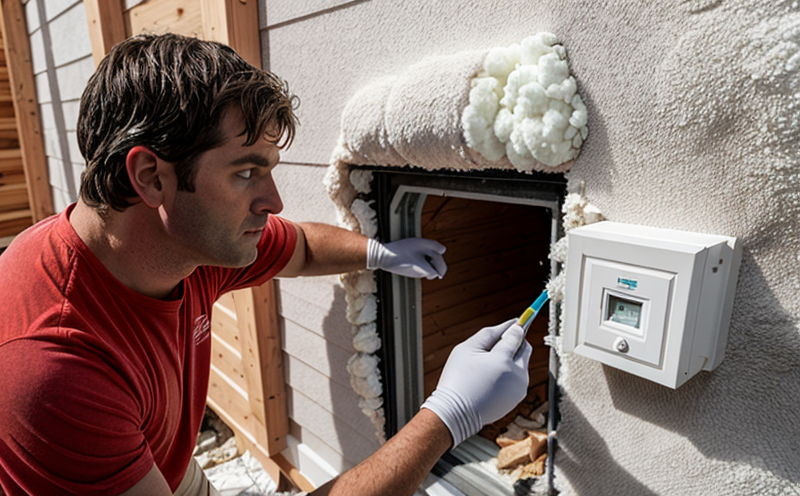ISO 8301 Thermal Conductivity Measurement of Panels
The ISO 8301 standard provides a method for measuring the thermal conductivity of insulating panels. This is crucial in the building and infrastructure testing sector, especially when it comes to ensuring that insulation materials meet specified performance criteria.
Thermal conductivity measurement is essential because it directly influences the energy efficiency and comfort levels within buildings. Panels with lower thermal conductivity are more effective at maintaining temperature stability, reducing heat loss or gain, and minimizing energy consumption for heating and cooling systems. This becomes particularly important in both residential and commercial settings where insulation performance can significantly impact long-term operational costs.
The test method described by ISO 8301 involves conditioning the specimen under specified environmental conditions before placing it between two temperature-controlled plates. A steady heat flux is then applied, and the resulting temperature difference across the sample is measured to calculate its thermal conductivity value. The accuracy of this measurement depends on precise control over all variables involved—such as initial moisture content, surface emissivity, and boundary conditions.
For accurate results using ISO 8301, it's important to ensure that specimens are representative of real-world applications. Specimen preparation should follow strict guidelines provided in the standard, including cutting dimensions and thicknesses appropriate for the intended use case. Additionally, considerations must be made regarding edge effects which can affect measurements if not properly addressed.
Understanding how different factors influence thermal conductivity is key to interpreting results correctly. For instance, variations in material composition or manufacturing processes could lead to significant differences between samples from various suppliers or even within batches produced by the same manufacturer. Therefore, adherence to internationally recognized standards like ISO 8301 ensures consistency and comparability across diverse datasets.
Implementing this test not only helps manufacturers improve product quality but also supports architects, engineers, and builders in selecting appropriate materials for their projects. By providing reliable data on thermal conductivity, these professionals can make informed decisions that contribute to sustainable design practices aimed at reducing carbon footprints associated with construction activities.
In summary, the ISO 8301 standard plays a vital role in ensuring consistent quality control during production and subsequent performance evaluation post-installation. Its application supports compliance requirements set forth by regulatory bodies worldwide while fostering innovation through continuous improvement efforts based on sound scientific principles.
Applied Standards
The primary standard applied in this testing procedure is ISO 8301:2014, which specifies the procedure for determining the thermal conductivity of insulating panels. However, other relevant standards include ASTM C518 and EN 12667, both of which provide additional guidance on specimen preparation and handling.
ISO 8301 outlines detailed procedures covering sample conditioning, testing setup, data acquisition methods, and result interpretation. It emphasizes the importance of maintaining controlled environmental conditions throughout the entire process to minimize any potential sources of error. Compliance with these standards ensures accurate measurement results that are reliable and reproducible.
Benefits
Ensures compliance with international regulations and industry best practices.
Aids in the development of high-performance insulation materials tailored to specific project needs.
Promotes energy efficiency by optimizing thermal performance, leading to reduced heating/cooling costs.
Supports sustainable construction practices through informed material selection.
By adhering to ISO 8301 standards during the testing process, laboratories can provide clients with robust evidence supporting claims about their products' thermal properties. This enhances credibility among stakeholders and contributes positively towards achieving green building certifications like LEED or BREEAM.
Customer Impact and Satisfaction
Enhances customer trust by providing verifiable data that supports claims about product performance.
Facilitates informed decision-making for architects, engineers, and builders who rely on accurate test results when specifying materials.
Supports sustainable development goals by helping to reduce environmental impact associated with heating/cooling systems in buildings.
Achieving satisfactory outcomes through rigorous testing processes based on ISO 8301 helps meet customer expectations and fosters long-term business relationships. Clients appreciate the transparency offered by such services, knowing that they receive unbiased assessments backed by recognized international standards.





